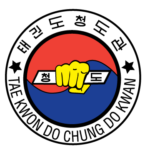About Chung Go Kwan
Taekwondo
In 1942, a gentleman by the name of Won Kuk Yi (pronounced Lee) founded a unique method of teaching TaeKwonDo to a group of
students rather than “one on one.” He called his method of teaching “Chung Do Kwan,” which can be translated several ways, such as “The Great Blue Wave” and many other translations relating to man’s first source of power-“the force of water.” However, GrandMaster Sell prefers to use the translation “a mighty wave smashing against a rocky shore,” meaning that the power of water striking against any living of lifeless form on earth will win. Today, Chung Do Kwan is one of Korea ‘s strongest TaeKwonDo training systems and Mr. Won Kuk Yi (1907-2003) has been given the title as a Great Great GrandMaster and Founder, and is a National Treasure in South Korea.
In 1967, GrandMaster Sell founded the American branch of the TaeKwonDo Chung Do Kwan Association, with the emphasis on strict discipline, shifting of body weight at the point of impact, and many other teaching techniques that would inspire the American student. In a very short time he realized that he had created the beginning of a “scale model” TaeKwonDo institute that would be responsible for setting high standards throughout the Eastern part of the United States . In the late 1960’s and early 1970’s, many schools attempted to imitate the teaching methods that GrandMaster Sell created, but failed, due to lack of leadership ability.

POOM-SAE (FORMS)
According to Uhm Woon Kyu, the President of Taekwondo Chung Do Kwan (and former President of Kukkiwon), the Chung Do Kwan today follows the complete curriculum of Kukkiwon.
Some of the older Chung Do Kwan based schools practice the original Pyong-Ahn forms which LEE Won Kuk incorporated from Shotokan karate. (The Pyong-Ahn forms originated in Okinawa, where they are called Pinan. In Japan, these forms are called Heian.)
Schools tracing their lineage to Duk Sung Son when he founded the World Tae Kwon Do Association in the United States after leaving Korea also practice Kuk Mu forms.
Other older Chung do Kwan schools practice the Palgwae forms, a predecessor of the Taegeuk forms. After black belt, practitioners of the Kukkiwon system practice the Yudanja and Kodanja series of black belt Poomsae of the Kukkiwon (Koryo, Kumgang, Taebaek, Pyongwon, Sipjin, Jitae, Cheonkwon, Hansoo, Ilyo). Many Chung Do Kwan schools also practice the Chang Hun tul, even if they are not affiliated with the International Taekwon-Do Federation.

